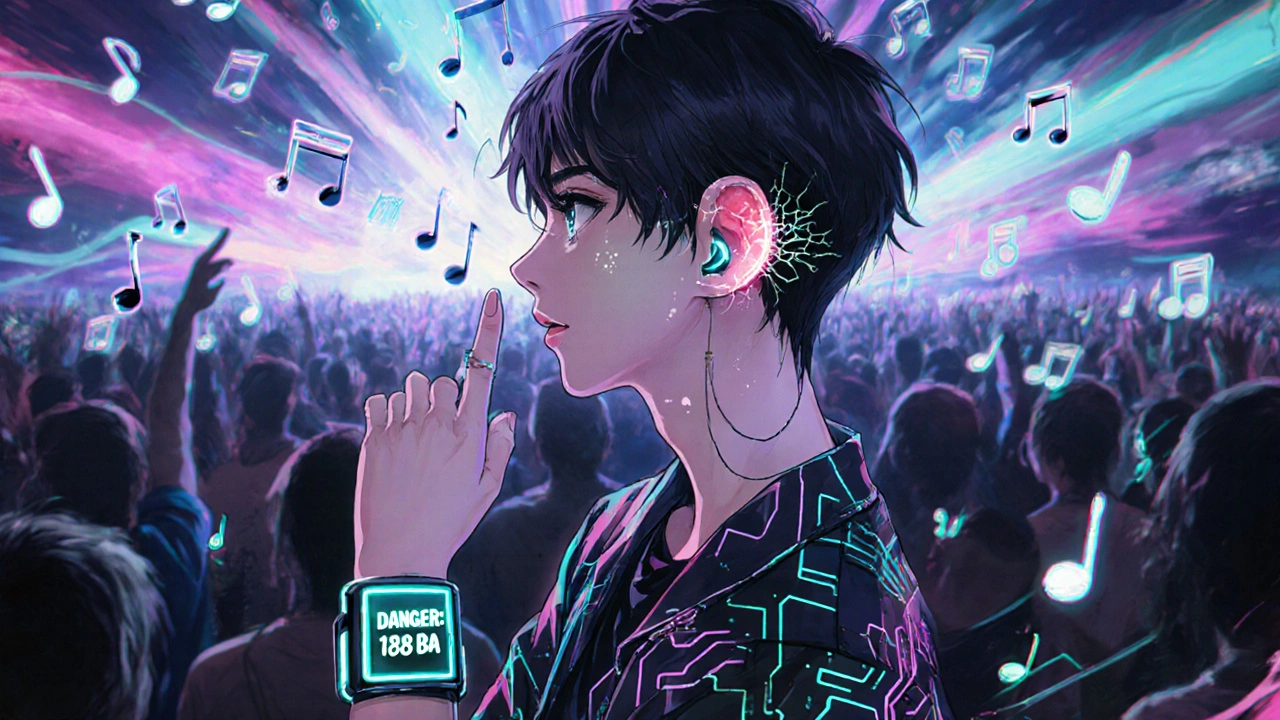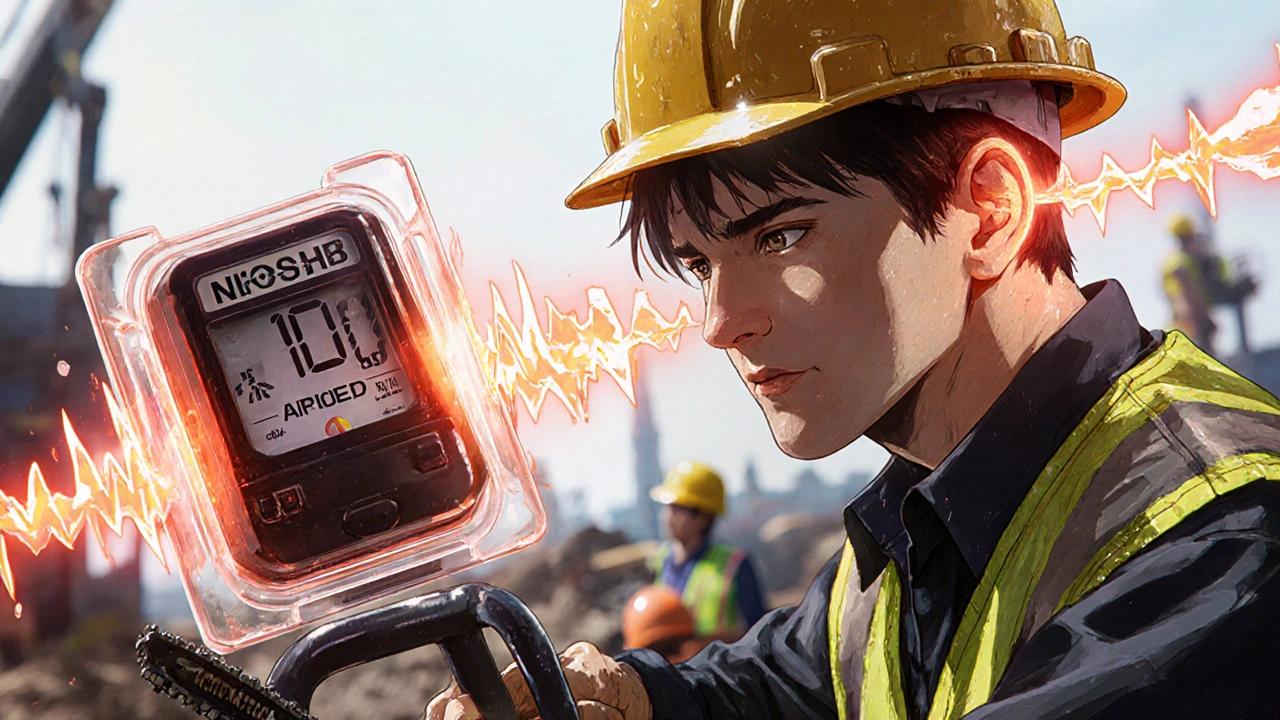Why Noise Exposure Limits Matter More Than You Think
You don’t need to be a construction worker or a rock musician to be at risk of permanent hearing damage. Every day, millions of people are exposed to dangerous noise levels-whether it’s the jackhammer next door, the earbuds blasting at the gym, or the bass thumping at a weekend concert. The problem isn’t just loudness. It’s duration and repetition. Noise-induced hearing loss (NIHL) doesn’t happen overnight. It creeps up slowly, often without pain or warning. By the time you notice muffled speech or ringing in your ears, the damage is already done-and it’s permanent.
Unlike other injuries, hearing loss can’t be fixed with surgery or medication. Once the hair cells in your inner ear are destroyed, they don’t grow back. That’s why science-backed noise exposure limits exist: to stop the damage before it starts. These aren’t arbitrary numbers. They’re based on decades of research from organizations like NIOSH, OSHA, and the World Health Organization. And the truth? Most people have no idea what’s safe and what’s not.
What Are the Official Noise Exposure Limits?
The key number to remember is 85 decibels (dBA). That’s the noise level at which health agencies agree you need to start taking action. NIOSH, the U.S. agency that studies workplace safety, says 85 dBA over an 8-hour day is the maximum safe exposure. Any louder, and your risk of hearing loss rises. But here’s the catch: OSHA, the agency that enforces workplace rules, lets employers expose workers to up to 90 dBA for 8 hours. That’s a 5-decibel difference-but in sound, that’s huge.
Decibels work on a logarithmic scale. A 3-decibel increase means double the sound energy. So if you’re exposed to 88 dBA, your safe time drops to 4 hours. At 91 dBA, it’s just 2 hours. At 100 dBA, NIOSH says you shouldn’t be exposed for more than 15 minutes without protection. OSHA, using a less protective 5-dB exchange rate, would allow 2 hours at 100 dBA. That’s a 700% difference in risk, according to the American College of Occupational and Environmental Medicine.
Internationally, standards are shifting toward NIOSH’s stricter model. The European Union sets its upper exposure limit at 87 dBA, including the protection from earplugs. Australia’s Safe Work Australia matches NIOSH at 85 dBA. China also follows the 85 dBA standard. Even the UK, which uses 80 dBA and 85 dBA as action levels, caps exposure at 87 dBA. The trend is clear: the scientific consensus favors 85 dBA as the line you shouldn’t cross.
How Noise Adds Up-Work and Play
Let’s break it down with real examples. A typical office is around 60 dBA. A vacuum cleaner? About 70 dBA. A lawnmower hits 90 dBA. A chainsaw? 110 dBA. If you use a chainsaw for 15 minutes, you’ve hit NIOSH’s daily limit. That’s why construction and manufacturing workers have the highest rates of hearing loss. In the U.S., 35% of reported cases come from manufacturing jobs.
But you don’t need power tools to be at risk. A concert can hit 110-120 dBA. A rock band on stage? 120 dBA. At that level, NIOSH says you’re at risk after just 7.5 minutes. And most concerts last two hours. Even if you’re not on stage, standing near the speakers puts you in danger. Studies show that 50% of concertgoers experience temporary hearing loss after an event. That’s not just a buzz-it’s a warning sign your ears are being damaged.
Personal audio devices are another silent threat. Listening to music at full volume on earbuds can hit 100 dBA. The World Health Organization recommends no more than 40 hours a week at 80 dBA. That’s about 5-6 hours a day at moderate volume. Most teens and young adults exceed that without realizing it. And unlike workplaces, there’s no safety officer checking your headphones.

What Employers Must Do (And What They Often Skip)
Under OSHA rules, employers must start a hearing conservation program when workers are exposed to 85 dBA or higher. That includes:
- Annual hearing tests (audiograms) to track changes
- Training on how to use earplugs and earmuffs correctly
- Providing free hearing protection
- Monitoring noise levels with sound meters
But here’s the problem: many employers only do the bare minimum. They hand out cheap foam earplugs and call it a day. NIOSH research shows that without proper fitting instructions, workers use hearing protection correctly less than 40% of the time. That’s why hands-on training-showing workers how to roll and insert earplugs, how to adjust earmuffs-boosts correct usage to 85%.
Real protection comes from engineering controls. That means quieter machines, sound barriers, or moving noisy tasks to isolated areas. For example, a factory that replaced old hydraulic presses with newer, quieter models cut noise levels from 95 dBA to 82 dBA. That’s not just safer-it saved them money on workers’ compensation claims. In 2022, hearing loss claims cost U.S. employers over $1 billion. Investing in quieter tools pays for itself.
What You Can Do at Concerts and Social Events
Concerts aren’t regulated like workplaces-but that doesn’t mean you’re powerless. Many venues now offer free or low-cost hearing protection. The Lifehouse Festival reports that 75% of attendees take the earplugs when offered. And they’re not just for musicians. Even if you’re just there to enjoy the music, you’re still exposed to dangerous noise.
Here’s what works:
- Use high-fidelity earplugs. These reduce volume without distorting sound. Brands like Etymotic and Loop make ones that let you hear the music clearly, just quieter.
- Take breaks. Step away from the speakers every 30 minutes. Even a 5-minute quiet break helps your ears recover.
- Use apps. New smartphone apps can measure noise levels with 92% accuracy. If your phone says it’s over 85 dBA, it’s time to protect yourself.
- Look for quiet zones. Some festivals now have areas with ambient noise around 70-75 dBA-perfect for resting your ears.
And if you’re a musician or work in live sound? Push for real-time noise displays. The American Speech-Language-Hearing Association says visible decibel meters at concerts help people make smarter choices. If you see a sign saying “Current Level: 115 dBA,” you’ll think twice before standing near the amps.

The Bottom Line: Prevention Is the Only Cure
Noise-induced hearing loss is 100% preventable. But it won’t stop unless you act. You don’t need to wait for a regulation to change. You don’t need to wait for your employer to do more. Start today.
Check your headphones. If you can’t hear someone talking to you while wearing them, the volume is too high. Turn it down. At work, if you’re around loud machinery, ask for hearing protection-even if you’re not officially required to use it. If you’re going to a concert, bring your own earplugs. They cost less than a coffee, and they’re the only thing standing between you and permanent hearing loss.
The science is clear. The tools are available. The cost of ignoring it? A lifetime of missed conversations, muffled voices, and constant ringing. That’s not just inconvenient. It’s isolating. Protect your hearing like you protect your eyesight. Because once it’s gone, you can’t get it back.
Frequently Asked Questions
What noise level is considered dangerous for hearing?
Any noise above 85 dBA (A-weighted decibels) over an 8-hour period is considered hazardous by NIOSH and other health agencies. For every 3-decibel increase, safe exposure time is cut in half. So at 88 dBA, you’re safe for only 4 hours. At 100 dBA, your limit is 15 minutes. Exposure to 120 dBA or higher-even for minutes-can cause immediate damage.
Is OSHA’s noise limit enough to protect my hearing?
No. OSHA allows up to 90 dBA for 8 hours, but NIOSH says that puts workers at a 25% risk of hearing loss over a working lifetime. NIOSH’s 85 dBA limit reduces that risk to under 8%. The difference isn’t just paperwork-it’s real, measurable hearing protection. Many experts and states like California now follow the stricter 85 dBA standard.
Can I use regular foam earplugs at concerts?
You can, but they’re not ideal. Foam earplugs reduce volume but muffle music, making it sound dull. High-fidelity earplugs, designed for musicians and concertgoers, use filters to reduce volume evenly across frequencies. That means you hear the music clearly-just at a safer level. Brands like Etymotic, Loop, and Vibes are widely recommended.
Do smartphone apps really measure noise accurately?
Yes. Research published in JAMA Otolaryngology in June 2023 found that smartphone apps can measure environmental noise with 92% accuracy compared to professional sound level meters. Apps like NIOSH’s Sound Level Meter or Decibel X are reliable for personal use. They won’t replace professional equipment, but they’re good enough to tell you when it’s time to protect your ears.
How do I know if I’ve already damaged my hearing?
Early signs include ringing in the ears (tinnitus) after loud events, difficulty understanding speech in noisy rooms, or feeling like people are mumbling. Temporary hearing loss after a concert is a red flag-it means your ears are struggling to recover. If you notice these symptoms regularly, get a hearing test. Audiologists test for threshold shifts at 2000, 3000, and 4000 Hz-the frequencies most affected by noise damage.
Are there quieter alternatives to loud power tools?
Yes. NIOSH’s 2023 "Buy Quiet" initiative lists 150 tools with lower noise ratings. For example, electric saws are often quieter than gas-powered ones. Battery-powered hedge trimmers can be 10-15 dBA quieter than gas models. Choosing quieter tools isn’t just safer-it reduces long-term costs for employers and workers. Many manufacturers now advertise noise levels on packaging.


Jennifer Walton
November 15, 2025 AT 19:29Kihya Beitz
November 15, 2025 AT 20:40John Foster
November 17, 2025 AT 14:11Andrew Eppich
November 18, 2025 AT 02:20Jessica Chambers
November 18, 2025 AT 15:28Shyamal Spadoni
November 19, 2025 AT 01:30Ogonna Igbo
November 20, 2025 AT 05:33BABA SABKA
November 20, 2025 AT 08:37Chris Bryan
November 20, 2025 AT 18:12Jonathan Dobey
November 22, 2025 AT 11:37ASHISH TURAN
November 22, 2025 AT 14:51Ryan Airey
November 22, 2025 AT 17:22Hollis Hollywood
November 22, 2025 AT 18:34